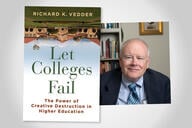You have /5 articles left.
Sign up for a free account or log in.
In pursuit of both prestige and tuition revenue, often to make up for declines in other forms of income, many four-year colleges and universities are making it more difficult for students from low-income backgrounds to afford a college education, according to a report released today by the New American Foundation.
The report, which looks at data from the 2010-11 academic year, found that at about two-thirds of the 479 private, nonprofit colleges and universities analyzed, students with annual family incomes of $30,000 or less had tuition bills that averaged more than $15,000 a year even after all forms of scholarship and grant aid were factored in. These institutions were often simultaneously doling out merit aid to wealthy students.
When it comes to institutions that give out large amounts of need-based aid, including many colleges and universities with large endowments, those institutions often enroll few low-income students, the report asserts.
“Besides the very richest colleges and some exceptional schools, nearly all private nonprofit colleges provide generous amounts of merit aid, often to the detriment of the low-income students they enroll,” the report states. “Many poorer schools provide deep discounts because they believe they must do so to survive, while other fairly wealthy schools use their aid as a competitive weapon to try to rise up the ranks and break into the top echelon of schools, as defined by publications such as U.S. News.”
According to the report, the increase in merit aid diverts resources away from need-based aid. And driving that increase in merit aid is the desire to increase the academic caliber of the student body while bringing in more money in tuition revenue, the report states.
These forces are increasingly linked, since those individuals who stand out on traditional measures of merit – test scores, grades and class rank – often tend to come from wealthier families. Both high-achieving and wealthy students are also often attracted to institutions with lots of resources and other high-achieving students. And since such students are in high demand, institutions often have to “buy” them by providing merit aid.
While such competition is more pronounced at private institutions, public colleges and universities – which educate the majority of all college students -- are coming under similar pressures. Over the past few years, as many states decreased the amount they appropriate for higher education on a per-student basis, public universities increasingly looked to tuition revenue to make up the difference. In doing so, they adopted many of the same tactics as their private peers, such as increasing the number of wealthier students by discounting tuition, often at the expense of seats and aid for low-income students.
Many college and university administrators say the trends are not an intentional move away from educating and proving aid for low-income students, but that institutions are simply doing what is necessary to remain financially viable and provide a good education. “I don’t think everything you see in here is intentional as much as it is a response to the ranking race, and declines in state support that are getting institutions to look for other forms of revenue,” said Michael Reilly, executive director of the American Association of Collegiate Registrars and Admissions Officers. “Public universities are relying more on tuition than they ever did.”
The shift of money away from need-based aid toward merit aid -- which studies show disproportionately goes to wealthy students and is often awarded to students with low test scores and grade point averages -- plays into several trends that are raising concern among the general public and lawmakers. Those trends include the growing debt burdens of college graduates, the potentially unsustainable business practice of discounting tuition rates, and the concentration of wealthy students at elite institutions when large numbers of low-income, high-achieving students are not being recruited.
About the Data:
Data used in the report come from the U.S. Department of Education.
Data reflect the 2010-11 academic year, the most recent year for which data are available.
Stephen Burd, the report’s author, is pessimistic that institutions will be able to reverse these trends on their own, saying instead that any change will have to come from state or federal lawmakers.
“These actions fly in the face of national goals to increase access to higher education and help more students get high-quality degrees,” the report states. “The time has come for policy makers to take notice. Federal action is needed to ensure that colleges continue to provide a gateway to opportunity, rather than perpetuating inequality by limiting college access to only those who are rich enough to be able to afford it.”
High Praise for High Aid
There are a handful of good actors in the space, Burd writes, that both serve a large percentage of low-income students and charge them a relatively low net price. Some of them are able to do so because of significant financial resources. Those include a handful of wealthy private liberal arts colleges such as Amherst, Bowdoin and Pomona Colleges. Larger wealthy institutions like Stanford, Rice and Cornell Universities also make the list.
A handful of non-wealthy private institutions also enroll large numbers of low-income students while keeping prices low. In this group Burd includes Reed College, Beloit College and Gallaudet University. These institutions accomplish this feat in different ways, but often it is achieved by not seeking prestige. Burd spotlights Reed, which is a respected liberal arts college but does not top rankings. The college’s previous president raised large amounts of money and refused to spend it on merit aid.
“It really is a question of leadership,” Burd said, pointing to the difference between such institutions and others with similar finances.
The final group of good actors, according to Burd, includes public universities in states that have kept tuition low, such as North Carolina, Wyoming, Hawaii, Florida and California. Some of these states have also supported state need-based aid programs.
But in recent years several institutions in these states have increased tuition prices as per-student funding by the state has decreased. As the state has cut appropriations to the University of California system, the basic undergraduate tuition fee for state residents at University of California institutions rose from $6,636 in 2007-8 to $12,192 this past year.
Overlooking Need
Many institutions – both public and private – charge low-income students minimal prices but fail to enroll them in large numbers. Harvard, Yale, Princeton, Duke and Vanderbilt Universities, whose student bodies include fewer than 15 percent Pell-eligible students, fall into this category.
Burd highlights Washington University in St. Louis, which had a net price of $0 for first-time, full-time students with family incomes of $30,000 or less in the 2010-11 school year. But the university's need-based aid budget was being spread across a small number of students. Only 7 percent of Washington University’s student body received Pell grants in the year examined.
Despite often being seen as avenues for social mobility, many selective public universities -- including many flagships -- followed similar patterns and come under similar scrutiny. For example, despite charging students in the lowest income bracket an average net price of less than $4,000 in the 2010-11 school year, the University of Virginia had a student body made up of only 13 percent Pell-eligible students.
This group of wealthy and selective institutions has come under scrutiny recently in the wake of a Brookings Institution report by Caroline M. Hoxby of Stanford and Christopher Avery of Harvard University, who found that the majority of high-achieving, low-income students do not apply to selective institutions and that these institutions do a poor job of recruiting them.
Institutions that come under particular scrutiny are the private universities and colleges with endowments of more than $500 million that enroll large numbers of low-income students without providing substantial aid.
The University of Miami, which is highlighted in the report, is one such institution. For the past few decades, the university has been investing heavily in recruiting high-achieving students. In the year examined, about a quarter of the university’s freshmen received some sort of merit aid averaging about $23,000 per student. While some of these awards went to low-income students, many did not. Students whose families made less than $30,000 a year paid an average net price of $21,415 in 2010-11.
A spokeswoman for the university said the college has been trying in recent years to increase the number of low-income students at the college and the amount of need-based aid it gives out. “At the University of Miami, we have been implementing a strategy that shifts that ratio,” she said. “We have been purposefully reducing merit aid so as to increase our need-based aid. For the incoming class, the numbers will be even more significant.”
The majority of private institutions -- 388 of the 479 analyzed in the report – enrolled a high percentage of low-income students and charged them more than $10,000 a year. While they don’t have the same resources as their wealthier peers, they are still doling out significant sums of merit aid, Burd found.
High Tuition, Low Aid
The movement away from state support for higher education has put many public universities in situations comparable to their private peers.
“Low-income students are generally doing much better at public colleges than at private ones,” the report states. “However, as public institutions deal with decreasing state funding and growing competition, particularly for out-of-state students, they are increasingly adopting the enrollment practices of their private college counterparts — to the detriment of low-income students.”
According to a 2011 survey of college and university admissions officers conducted by Inside Higher Ed, recruiting more “full-pay” students, those who don’t need financial aid, is a top goal at public universities. Admissions directors at public doctoral and master’s institutions were more likely to cite recruitment of full-pay students as a key strategy than providing aid for low-income students.
As states reduced per-student appropriations, many public institutions moved toward a “high-tuition, high-aid” model with the idea that new revenue from wealthier students can be used as aid for low-income students. That strategy does not seem to have played out. “This analysis finds that the high-tuition, high-aid approach has been a failure for low-income students,” the report states. “In many states that are following this model, such as Pennsylvania and South Carolina, the neediest students are facing net prices that are more than double what they are being charged in low-tuition states.”
Pennsylvania State University, for example, charged students whose parents make less than $30,000 a year an average net price of about $16,839 for the 2010-11 school year.
External Action
Higher education administrators say they face a situation where they cannot unilaterally disarm, since it would hurt their bottom line.
But even if they could, many said they’re not interested. According to a survey of college and university business officers conducted in 2012 by Inside Higher Ed, only about a third of college presidents said they would stop awarding non-need-based aid if their competitors did so.
An effort led by Kenyon College President Georgia Nugent to get a group of competing private institutions to shift their aid budgets away from non-need-based aid to need-based aid has not gained much steam so far.
Because of that, Burd said, it seems unlikely that the sector will shift gears any time soon.




